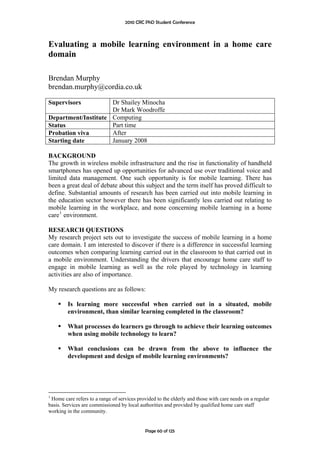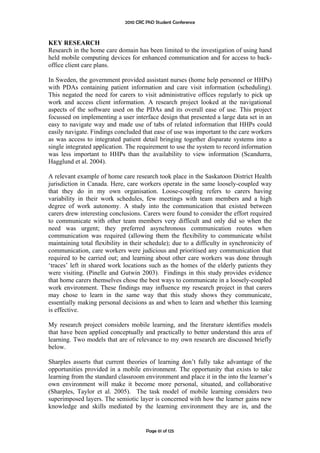Murphy
- 1. 2010 CRC PhD Student Conference Evaluating a mobile learning environment in a home care domain Brendan Murphy brendan.murphy@cordia.co.uk Supervisors Dr Shailey Minocha Dr Mark Woodroffe Department/Institute Computing Status Part time Probation viva After Starting date January 2008 BACKGROUND The growth in wireless mobile infrastructure and the rise in functionality of handheld smartphones has opened up opportunities for advanced use over traditional voice and limited data management. One such opportunity is for mobile learning. There has been a great deal of debate about this subject and the term itself has proved difficult to define. Substantial amounts of research has been carried out into mobile learning in the education sector however there has been significantly less carried out relating to mobile learning in the workplace, and none concerning mobile learning in a home care 1 environment. RESEARCH QUESTIONS My research project sets out to investigate the success of mobile learning in a home care domain. I am interested to discover if there is a difference in successful learning outcomes when comparing learning carried out in the classroom to that carried out in a mobile environment. Understanding the drivers that encourage home care staff to engage in mobile learning as well as the role played by technology in learning activities are also of importance. My research questions are as follows: Is learning more successful when carried out in a situated, mobile environment, than similar learning completed in the classroom? What processes do learners go through to achieve their learning outcomes when using mobile technology to learn? What conclusions can be drawn from the above to influence the development and design of mobile learning environments? 1 Home care refers to a range of services provided to the elderly and those with care needs on a regular basis. Services are commissioned by local authorities and provided by qualified home care staff working in the community. Page 60 of 125
- 2. 2010 CRC PhD Student Conference KEY RESEARCH Research in the home care domain has been limited to the investigation of using hand held mobile computing devices for enhanced communication and for access to back- office client care plans. In Sweden, the government provided assistant nurses (home help personnel or HHPs) with PDAs containing patient information and care visit information (scheduling). This negated the need for carers to visit administrative offices regularly to pick up work and access client information. A research project looked at the navigational aspects of the software used on the PDAs and its overall ease of use. This project focussed on implementing a user interface design that presented a large data set in an easy to navigate way and made use of tabs of related information that HHPs could easily navigate. Findings concluded that ease of use was important to the care workers as was access to integrated patient detail bringing together disparate systems into a single integrated application. The requirement to use the system to record information was less important to HHPs than the availability to view information (Scandurra, Hagglund et al. 2004). A relevant example of home care research took place in the Saskatoon District Health jurisdiction in Canada. Here, care workers operate in the same loosely-coupled way that they do in my own organisation. Loose-coupling refers to carers having variability in their work schedules, few meetings with team members and a high degree of work autonomy. A study into the communication that existed between carers drew interesting conclusions. Carers were found to consider the effort required to communicate with other team members very difficult and only did so when the need was urgent; they preferred asynchronous communication routes when communication was required (allowing them the flexibility to communicate whilst maintaining total flexibility in their schedule); due to a difficulty in synchronicity of communication, care workers were judicious and prioritised any communication that required to be carried out; and learning about other care workers was done through ‘traces’ left in shared work locations such as the homes of the elderly patients they were visiting. (Pinelle and Gutwin 2003). Findings in this study provides evidence that home carers themselves chose the best ways to communicate in a loosely-coupled work environment. These findings may influence my research project in that carers may chose to learn in the same way that this study shows they communicate, essentially making personal decisions as and when to learn and whether this learning is effective. My research project considers mobile learning, and the literature identifies models that have been applied conceptually and practically to better understand this area of learning. Two models that are of relevance to my own research are discussed briefly below. Sharples asserts that current theories of learning don’t fully take advantage of the opportunities provided in a mobile environment. The opportunity that exists to take learning from the standard classroom environment and place it in the into the learner’s own environment will make it become more personal, situated, and collaborative (Sharples, Taylor et al. 2005). The task model of mobile learning considers two superimposed layers. The semiotic layer is concerned with how the learner gains new knowledge and skills mediated by the learning environment they are in, and the Page 61 of 125
- 3. 2010 CRC PhD Student Conference technological layer considers how the learner engages with technology to learn. These two layers enable this model to be used in a flexible way in terms of research, as it enables focus on the tools used for learning or the success of the actual learning itself. This model also considers the socio-cultural factors of control, context and communication related to mobile learning. These are important considerations as learning is rarely a singular activity, relying on interactions with educators, technologies and other learners. Frohberg explains these factors describing the portability of mobile learning as providing the means to learn in context, which in turn presents the challenge of moderating the learning in some way (control) and communication increases the success of learning when learners/educators share and learn together (communication.) (Frohberg, Goth et al. 2009). A second relevant model is Koole and Ally’s ‘framework for the rational analysis of mobile education’ (FRAME) model which can be used to help inform a better understanding of mobile learning. This model was designed to determine the effectiveness of devices used for mobile learning as well as addressing the relationship between mobile learning, human capability to learn and social interaction in learning. The FRAME model helps researchers gain a better understanding of the complex nature of mobile learning. The model considers three aspects namely; the device; the learner; and the social aspects of mobile learning. The model asserts that convergence of these aspects can lead to better collaboration amongst learners, access to information and a better understanding of learning (Koole and Ally 2006). RESEARCH METHODOLOGY Adopting a socially constructed approach to research is important where there is a requirement to be more absorbed and involved in the research process itself. In relation to this approach, Saunders determines the importance of understanding the subjective meaning that motivates actions to fully understand the actions themselves (Saunders, Lewis et al. 2003). The home care domain is rich and complex and this makes it suited to this type of approach. Table 1 shows my summary research activities and proposed methods. Phase Research Question Methods Used ONE Is learning more successful Survey when carried out in a situated, mobile environment, than Direct observation similar learning completed in the classroom? User profiles/personas TWO What processes do learners go Diary study through to achieve their learning outcomes when using mobile technology to learn? THREE What conclusions can be Focus groups drawn from the above to influence the development and design of mobile learning environments? Table 1 – proposed research methods Page 62 of 125
- 4. 2010 CRC PhD Student Conference FINDINGS I have carried out pilot empirical research activities with a small group of home care staff and managers. Activities included a domain analysis and a user profile. The aim of these limited activities was to give me a more detailed understanding of the domain as well as the level of technology deployed and the success of this technology in the domain. Domain analysis The home care service in Glasgow is a complex one that provides a range of services delivered every day of the year, and for 24 hours each day. Over 3000 carers work in the service and they are supervised by 220 home care co-ordinators. On a daily basis, 10000 clients receive a service. Clients are largely elderly or are adults with physical or learning disabilities. Home care co-ordinators are generalists, each carrying out a full range of care duties. Previously, specialist co-ordinators provided medical tasks such as wound dressing, cream application and stoma care. These tasks are now carried out by all home carers. Home care co-ordinators carry out administrative duties in support of a team of 10 basic home carers though they also provide care services to a reduced number of clients on a daily basis. Organising learning in the home care service is difficult and this is principally due to the logistics of covering duty shifts and the requirement to provide continuity of care at all times for clients making it undesirable to replace carers on a regular basis. The organisational learning activities offered to home care staff are delivered from one purpose-built centre situated in the North of Glasgow. Due to capacity issues in this learning centre, only statutory learning required by monitoring authorities is offered to home care co-ordinators. User profile The home care user profile identified carers as being largely female, in their mid-40s with a basic secondary school education. Carers have limited IT ability though this was largely perceived by the carers themselves (and by the IT staff supporting them) – and with probing this was not necessarily the case with home carers showing some technical ability when using personal technologies such as MP3 players, digital TV and digital cameras. The principal reason for home carers working in the domain is their inherent desire to care for those who are elderly and vulnerable. Home carers adopt technology with relative ease and the use of new technologies at work has made them more disposed to their adoption. The role of informal technology champions when new technology is implemented is a critical one. ENDS Page 63 of 125
- 5. 2010 CRC PhD Student Conference REFERENCES Frohberg, D., C. Goth, et al. (2009). "Mobile learning projects - a critical analysis of the state of the art." Journal of Computer Assisted Learning(25): 307-331. Koole, M. and M. Ally (2006). Framework for the Rational Analysis of Mobile Education (FRAME) Model: Revising the ABCs of Educational Practices. Networking, International Conference on Systems and International Conference on Mobile Communications and Learning Technologies. Pinelle, D. and C. Gutwin (2003). Designing for Loose Coupling in Mobile Groups. GROUP '03. Sanibel Island, Florida, USA, ACM: 75-84. Saunders, M., P. Lewis, et al. (2003). Research Methods for Business Students. Harlow, Pearson Education Limited. Scandurra, I., M. Hagglund, et al. (2004). Integrated Care Plan and Documentation on Handheld Devices in Mobile Home Care. MobileHCI 2004, Glasgow, Scotland. Sharples, M., J. Taylor, et al. (2005). "Towards a Theory of Mobile Learning." Centre for Educational Technology and Distance Learning, University of Birmingham: 9. Page 64 of 125




